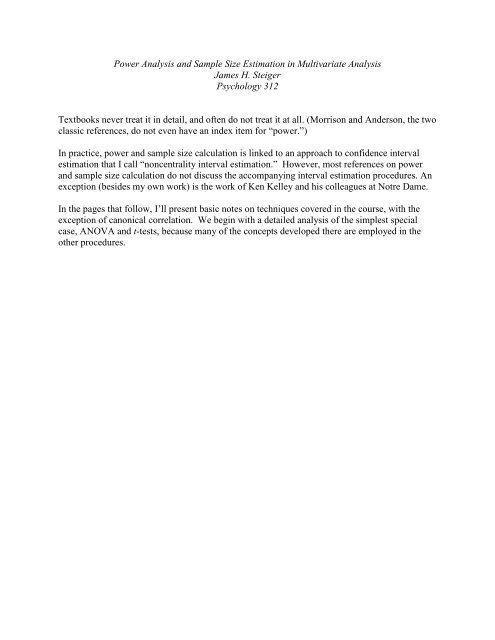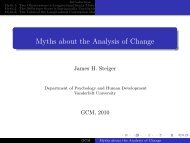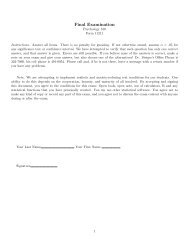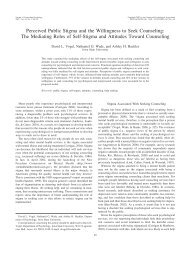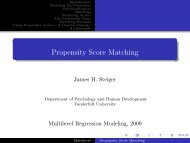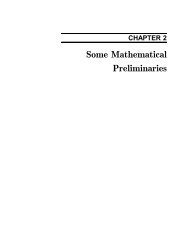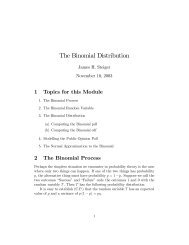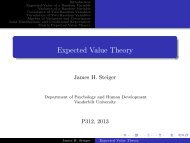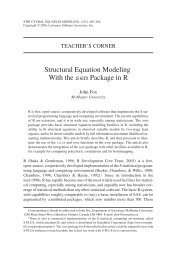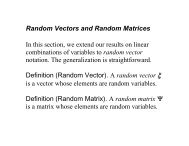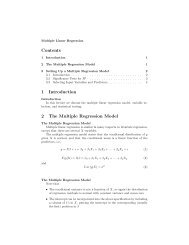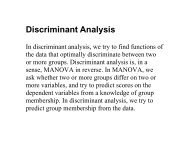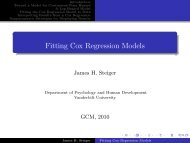Power Analysis Notes - Statpower
Power Analysis Notes - Statpower
Power Analysis Notes - Statpower
Create successful ePaper yourself
Turn your PDF publications into a flip-book with our unique Google optimized e-Paper software.
<strong>Power</strong> <strong>Analysis</strong> and Sample Size Estimation in Multivariate <strong>Analysis</strong><br />
James H. Steiger<br />
Psychology 312<br />
Textbooks never treat it in detail, and often do not treat it at all. (Morrison and Anderson, the two<br />
classic references, do not even have an index item for “power.”)<br />
In practice, power and sample size calculation is linked to an approach to confidence interval<br />
estimation that I call “noncentrality interval estimation.” However, most references on power<br />
and sample size calculation do not discuss the accompanying interval estimation procedures. An<br />
exception (besides my own work) is the work of Ken Kelley and his colleagues at Notre Dame.<br />
In the pages that follow, I’ll present basic notes on techniques covered in the course, with the<br />
exception of canonical correlation. We begin with a detailed analysis of the simplest special<br />
case, ANOVA and t-tests, because many of the concepts developed there are employed in the<br />
other procedures.
Basic Concepts via t-test and 1-Way ANOVA<br />
Standardized Effect Size<br />
One Sample t<br />
E s<br />
µ − µ 0<br />
=<br />
σ<br />
2-Sample t<br />
E s<br />
µ 1−<br />
µ 2<br />
=<br />
σ<br />
General Distribution<br />
One Sample t<br />
t λ λ<br />
n− 1, , =<br />
nEs<br />
2-Sample t<br />
,<br />
nn<br />
1 2<br />
t n 1+ n 2− 2, λ λ = E s<br />
n1+<br />
n2<br />
Interval Estimation<br />
Estimate E s rather than simply test a null hypothesis. See Steiger and Fouladi<br />
(1997) for details. See the MBESS package in R and its documentation for routines.<br />
Equivalence Testing<br />
A simple approach is to see if the entire 1− 2α confidence interval for E s fits<br />
within a “zone of triviality.”<br />
Precision Planning versus <strong>Power</strong> Planning<br />
Choose a sample size so that the standard error of E s is sufficiently small.<br />
Alternatively, the AIPE (Accuracy in Parameter Estimation) approach of Ken Kelley is to plan<br />
sample size so that the expected width of the confidence interval is sufficiently small.
Factorial ANOVA<br />
1-Way<br />
Standardized Effect Size. We seek a multi-sample analogue of<br />
several alternative measures. With a levels of the A factor, Cohen’s f is<br />
E s . There are<br />
f<br />
2<br />
a<br />
2<br />
⎛ j − ⎞<br />
a<br />
⎛α j ⎞ µ µ<br />
∑⎜<br />
⎟ ∑⎜<br />
⎟<br />
j= 1⎝<br />
σ ⎠ j=<br />
1⎝<br />
σ ⎠<br />
= =<br />
a<br />
a<br />
The distribution of the F statistic is noncentral Fa−1, an ( − 1), λ , with noncentrality<br />
parameter λ given by<br />
a<br />
⎛α<br />
j ⎞<br />
λ = n∑<br />
⎜ ⎟<br />
j=<br />
1⎝<br />
σ ⎠<br />
2<br />
= naf =<br />
2 2<br />
Ntot<br />
f<br />
One may calculate power and sample size for a given f directly from the<br />
noncentral F distribution in R. This is automated very nicely in the program Gpower 3.<br />
This relationship may also be “turned around” to generate a confidence interval<br />
for λ , and ultimately, for f. This calculation may be performed using the routines in the R<br />
package MBESS.<br />
2-Way and Beyond<br />
Except for degrees of freedom, little changes. For main effect or interaction θ , the noncentrality<br />
parameter may be calculated directly as<br />
λ =<br />
θ<br />
Ntot<br />
2<br />
θ<br />
f<br />
For a detailed treatment of confidence interval estimation in the context of ANOVA and<br />
regression, consult the book chapter by Steiger and Fouladi (1997), and the journal article by<br />
Steiger (2004).
Multiple Regression with Fixed Regressors<br />
Test that<br />
2<br />
ρ = 0<br />
With a sample size of n, number of predictors k, the F statistic is<br />
F<br />
kn , −k, λ<br />
2<br />
2<br />
R / k<br />
=<br />
( 1− R ) / ( n−k−1)<br />
This is distributed as a noncentral F with noncentrality parameter<br />
2<br />
λ = n<br />
ρ<br />
2<br />
1−<br />
ρ<br />
Hence, it is rather straightforward to calculate power for a given ρ<br />
2 , kn , . In any given situation,<br />
2<br />
one may plot power as a function of n for a given ρ and k , and then compute required sample<br />
size by inverting the function plot. This is nicely automated in numerous programs, including<br />
the freeware program Gpower 3.<br />
This same approach can also be used to perform power and sample size analysis for tests of an<br />
additional predictor or group of predictors.<br />
For details, see Faul, et al (2007), p. 181.
Multiple Regression with Random Regressors<br />
The non-null distribution in the case of random regressors is much more complicated than for the<br />
fixed regressors case. As a consequence, most people relied on fixed regressor calculations as an<br />
approximation. In 1992, Steiger and Fouladi produced R2, the first program that could calculate<br />
2<br />
the exact distribution of R . The program performed a full range of power and sample size<br />
2<br />
calculations for tests that ρ = c , where c need not be zero. In addition, the program produced an<br />
2<br />
exact confidence interval on ρ . The power and sample size calculations are available in<br />
Gpower 3 and MBESS, and the confidence interval calculations can be performed by MBESS.
Structural Equation Modeling, Factor <strong>Analysis</strong>, Confirmatory Factor <strong>Analysis</strong><br />
Fitting a model by maximum likelihood involves minimizing the maximum likelihood criterion<br />
F( SM , ( θ )) . The standard test statistic is the chi-square statistic ( N −1) F( SM , ( θ )) . Steiger,<br />
Shapiro, and Browne (1985) showed that this statistic has approximately a noncentral chi-square<br />
distribution with noncentrality parameter<br />
λ = ( N − 1) F<br />
*<br />
*<br />
where F is the population discrepancy function, i.e., the value of the discrepancy function that<br />
would be obtained if the population covariance matrix Σ were available and analyzed by<br />
maximum likelihood.<br />
Steiger and Lind (1980) proposed the RMSEA as an index of population badness of fit. (See<br />
handout on Fit Indices in SEM at the course website.) This index is<br />
RMSEA =<br />
*<br />
F<br />
ν<br />
*<br />
where ν is the degrees of freedom for the model. Work by Browne (1977) had shown that F is<br />
closely approximated by a sum of squared orthogonalized model errors, much the same as the<br />
squared Mahalanobis distance in form, i.e.,<br />
F<br />
* −1<br />
≈ e'<br />
Γ<br />
where e is a vector of discrepancies between the elements of Σ and the model’s approximation<br />
of them, and Γ is the covariance matrix of the elements of S. So the RMSEA is essentially a<br />
root-mean-square-error of approximation of the model to the data. This means that the<br />
noncentrality parameter may be calculated as<br />
e<br />
λ = ( n = 1) ν × RMSEA<br />
MacCallum, Browne, and Sugawara (1996) suggested a formal hypothesis test of target values of<br />
the RMSEA. The traditional test is, of course, a test that the population RMSEA = 0.<br />
Steiger (1990) favored a confidence interval based approach, centering on what MacCallum,<br />
Browne, and Sugawara termed a test of not-close-fit, corresponding to the standard approach in<br />
biostatistics “bioequivalence testing.”<br />
MacCallum, Browne, and Sugawara produced sample size tables. Steiger (1999) included a<br />
power and sample size calculator in the program Statistica <strong>Power</strong> <strong>Analysis</strong>. Ken Kelley includes<br />
routines to perform calculations on these procedures in the R package MBESS.<br />
2
Hotelling’s<br />
2<br />
T<br />
The Squared Mahalanobis Distance<br />
The Ψ index: Ψ=<br />
2<br />
∆<br />
k<br />
2 −1<br />
= µ 2 µ 1 Σ µ 2 µ 1<br />
∆ ( − )' ( − )<br />
One Sample<br />
2 −1 2<br />
= x−µ 0 S x− µ 0 = ∆<br />
T n( )' ( ) n ˆ<br />
F<br />
k−1, n−k− 1, λ =<br />
n− k+<br />
1<br />
T<br />
( n −1)( k −1)<br />
2<br />
Two Sample<br />
2 2<br />
λ = n∆ = nkΨ<br />
T<br />
nn<br />
nn<br />
2 1 2 −1 1 2 2<br />
= ( x1−x2)' Σ ( x1− x2)<br />
= ∆<br />
n1+ n2 n1+<br />
n2<br />
nn nn<br />
λ = ∆ = kΨ<br />
n + n n + n<br />
1 2 2 1 2 2<br />
1 2 1 2<br />
ˆ
Binary Logistic Regression<br />
G<strong>Power</strong> 3 gives power calculation for a single predictor, in terms of the null hypothesized<br />
probability of the response = 1 given X = 1. One simply specifies the odds ratio and sample size,<br />
and the program calculates power. Or, alternatively, one specifies power and the odds ratio, and<br />
the program computes sample size.<br />
G<strong>Power</strong> 3 also computes power and sample size for testing an additional predictor. One must<br />
2<br />
specify the ρ for the other predictors, which is of course largely based on guesswork.<br />
Theory underlying the tests in G<strong>Power</strong>3 is given in Hsieh (1989) and discussed in detail in<br />
Hosmer and Lemeshow, Applied Logistic Regression, p. 339–347.
MANOVA<br />
<strong>Power</strong> and sample size analysis in MANOVA requires specification of numerous parameters that<br />
you are unlikely to know. It is not for the faint of heart, but an approach is implemented in<br />
Gpower 3 and discussed in the tutorial, available for download online.<br />
Faul, et al. (2007) give a thorough discussion of the theory behind the methods employed in<br />
G<strong>Power</strong>3. An alternate, somewhat simpler approach that Faul et al. claim is slightly less accurate<br />
is given by Muller et al (1992). Their approach is very general.


